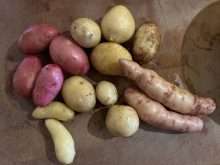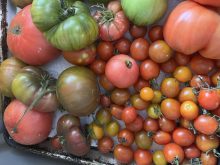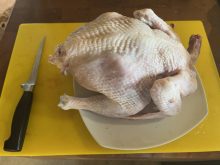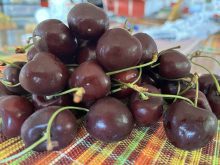When I told her I thought I was a changeling, my mom laughed out loud. “With those eyes? Those cheeks? That chin? You are the spitting image of your Aunt Lila.”
It’s true. In the mirror, I see my family staring back, just as when I look at my sons, I see my dad’s face. There’s no doubt that we are related. I recall taking my youngest son, still a babe in arms, and his brother, then four, out for noodles in our favourite Vietnamese restaurant. A stranger stopped at our booth as we ate our pho. “Your children are your clones,” she said, laughing. “You all three look so alike.”
My sons and I still eat pho together. We have flavours in common too, separated only by the Bay of Bengal and the South China Sea. My boys lean towards southeast Asian ingredients, while I cook South Asian (Indian) dishes as my go-to.
Read Also

Gentle treatments for pain in the neck
Heading toward year-end, people unknowingly tense up against the cold and busyness, causing neck pain that can often be treated with appropriate support and gentle mobility, athletic therapist Kathlyn Hossack says.
That makes all three of us culinary changelings. While we like foods in the Euro style, we love cumin, ginger, garlic, coconut milk, mint, lime, coriander, basil. These seasonings are common to the cuisines of Thailand, Vietnam, and parts of India, Pakistan, and Bangladesh.
One gift I gave this past Christmas was my own garam masala, the personalized spice blend I make to use in Indian dishes. How? Cumin seed, coriander seed, fennel seed, shelled green cardamom pods, peppercorns, mustard seed, anise seed, whole star anise, fenugreek, stick cinnamon, whole cloves and allspice, all dry roasted and ground, then mixed with sweet paprika, chili powder, and turmeric. But listen up: garam masala is easy to make in bulk, but share it with spice-loving friends, as ground spices go stale more quickly than whole.
In fact, that tip — start with whole spices — is extra important when making the foods of South Asia. It doesn’t mean that you have to roast and grind spices each time you cook, but if you do make your own garam masala instead of using commercial curry powders or spice blends, your food will have so much more flavour!
Masala means spice mixture. It applies to chai, or tea. Chai masala is the perfect conclusion to an Indian meal, although I drink it beforehand too. This blend of black tea steeped with milk and whole spices — cinnamon sticks, cracked green cardamom pods, cloves, nutmeg, star anise — can season panna cotta, ice cream or crème caramel, or it can be ground, with or without the tea, for use in cheesecakes and spice cakes, poaching liquids and beverages, tarts and cookies.
The next few columns will serve some favourite South Asian dishes, starting with a vegetarian appetizer that we have been known to eat for supper all on its own. Pakoras are fritters served with chutney. Once you make pakoras at home, you will have an indelible benchmark of quality to evaluate any you eat at restaurants. First we eat fritters, then we discuss spices.

Vegetable Pakoras with Mint Chutney
Bound with chickpea flour and buttermilk (or coconut milk if you are vegan), the vegetables in pakoras can vary: some restaurants use mostly potato, an inexpensive choice, to which I add cauliflower and carrots, peppers, zucchini, and sometimes cooked and chopped chickpeas. Makes many.
- 3 c. chickpea flour
- 1 jalapeno, seeded and minced, optional
- 1 tbsp. minced fresh mint or cilantro
- Salt to taste
- 1 tbsp. homemade garam masala or curry powder
- 1 tbsp. olive oil
- 1/2 tsp. lemon juice
- 2 c. buttermilk, more as needed
- 3 large potatoes, julienned
- 1 onion, thinly sliced
- 1 zucchini, shredded
- 1 bell pepper, cut in strips
- 1/2 cauliflower, small florets
- 1 tbsp. minced garlic
- 1 tbsp. minced ginger root
- Vegetable oil for pan-frying
- Mint or Cilantro Chutney (see recipe below)
Stir together the dry ingredients, then add the liquids. The batter should be fairly loose. Add the vegetables and seasonings. Mix only until blended.
Pour oil to a depth of 1/2 inch into a wide, shallow, heavy-bottomed pan. Heat to 350 F. Check for heat by carefully splashing a few drops of water into the oil: when it sizzles immediately, the oil is hot enough. Set a paper-lined tray close by.
Using a pair of spoons, drop spoonfuls of batter carefully into the hot fat from as close to the surface as possible to avoid splashing.
Do not overcrowd the pan; a single layer, with room between the fritters, is ideal to maintain an even temperature. Use spring-loaded tongs to turn each fritter once as it becomes golden. Cook on second side, then remove to the tray.
Serve hot with chutney.
Fresh Mint or Cilantro Chutney
Serve with pakoras, curry, seafood and lamb dishes. Makes about 2 cups.
- 1 c. packed cilantro or mint leaves, stalks discarded
- 4 green onions
- 1/2 c. flat-leaf parsley
- 1 jalapeno pepper, seeded and coarsely chopped, or hot chili paste to taste
- 2 garlic cloves, peeled
- 2 slices ginger root
- 1/4 c. lemon juice
- 1 tsp. garam masala
- 3 tbsp. sugar
- Salt to taste
- 1/2-1 c. water or orange juice
Purée solids in food processor, then add liquid.
















